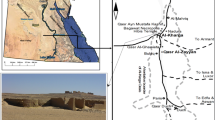Abstract
This paper is inserted into the framework of inverse scattering with application to Ground Penetrating Radar (GPR) data and is meant to provide a method helping to apply inverse scattering algorithms to electrically large investigation domains. In particular, we focus on the depth slices that are particularly important in application on cultural heritage and propose in relationship with the depth slices a strategy that we will call “shifting zoom” that is specifically a method to mitigate the effects of the limited view angle in the linear tomographic inversion applied to GPR data. In particular, this paper is an extended version of the contribution (Persico et al. in: Proceedings of Imeko international conference on metrology for archaeology and cultural heritage, Lecce, Italy, 2017a), published in the Proceedings of the conference metrology for archaeology 2017. We propose here a validation of the shifting zoom versus experimental data gathered in a controlled test site, and we will show the effect of the shifting zoom on depth slices achieved from these data after a linear inverse scattering processing has been applied for their focusing.






Similar content being viewed by others
References
Allred BJ, Redman D (2010) Location of agricultural drainage pipes and assessment of agricultural drainage pipe conditions using ground penetrating radar. J Environ Eng Geophys 15:119–134
Bertero M, Boccacci P (1998) Introduction to inverse problems in imaging. Institute of Physics Publishing, Bristol
Bevan B (1991) The search for graves. Geophysics 56:1310–1319
Campana S, Piro S (2009) Seeing the unseen: geophysics and landscape archaeology. CRC Press, Boca Raton
Caorsi S, Pastorino M (2000) Two-dimensional microwave imaging approach based on a genetic algorithm. IEEE Trans Antennas Propag 48(3):370–372
Chianese D, D’Emilio M, Di Salvia S, Lapenna V, Ragosta M, Rizzo E (2004) Magnetic mapping, ground penetrating radar surveys and magnetic susceptibility. Measurements for the study of archaeological site of Serra di Vaglio (southern Italy). J Archaeol Sci 31:633–643
Collin RE (2001) Foundations of microwave engineering, 2nd edn. Wiley, Hoboken
Conyers LB (2004) Ground penetrating radar for archaeology. Alta Mira Press, Walnut Creek
Conyers LB, Goodman D (1998) Ground penetrating radar: an introduction for archaeologists. AltaMira Press, Walnut Creek
Daniels DJ (2004) Ground penetrating radar. IEEE, London
Gabellone F, Ferrario I, Giuri F, Limoncelli M (2010) Virtual Hierapolis: tra tecnicismo e realismo, in Arqueológica 2.0, II Congreso Internacional de Arqueología e Informática Gráfica, Patrimonio e Innovación, Sevilla, 16–19 Junio 2010, pp 279–284
Gennarelli G, Catapano I, Soldovieri F, Persico R (2015) On the achievable imaging performance in full 3-D linear inverse scattering. IEEE Trans Antennas Propag 63(3):1150–1155
Goodman D, Nishimura Y, Rogers JD (1995) GPR time slices in archaeological prospection. Archaeol Prospect 2:85–89
Hansen TB, Johansen PM (2000) Inversion scheme for ground penetrating radar that takes into account the planar air–soil interface. IEEE Trans Geosci Remote Sens 38(1):23–34
Kadioglu S, Kadioglu YK (2010) Picturing internal fractures of historical statues using ground penetrating radar method. Adv Geosci 24:23–34
Lambot S, André F (2014) Full-wave modeling of near-field radar data for planar layered media reconstruction. IEEE Trans Geosci Remote Sens 52:2295–2303
Leucci G, Greco F (2012) 3d electrical resistivity tomography to reconstruct archaeological features in the subsoil of the “spirito santo” church ruins at the site of occhiola’ (sicily, italy). Archaeology 1(1):1–6
Linford NT, Linford PK (2004) Short report, ground penetrating radar survey over a Roman Building at Groudwell Ridge, Blunsdon St Andrew, Swindon, UK. Archaeol Prospect 11:49–55
Liseno A, Tartaglione F, Soldovieri F (2004) Shape reconstruction of 2d buried objects under a Kirchhoff approximation. IEEE Geosci Remote Sens Lett 1(2):118–121
Mertens L, Persico R, Matera L, Lambot S (2016) Smart automated detection of reflection hyperbolas in complex GPR images with no a priori knowledge on the medium. IEEE Trans Geosci Remote Sens 54(1):580–596
Persico R (2014) Introduction to ground penetrating radar: inverse scattering and data processing. Wiley, Hoboken. ISBN 9781118305003
Persico R, Sala J (2014) The problem of the investigation domain subdivision in 2D linear inversions for large scale GPR data. IEEE Geosci Remote Sens Lett 11(7):1215–1219. https://doi.org/10.1109/LGRS.2013.2290008
Persico R, Pochanin G, Ruban V, Orlenko A, Catapano I, Soldovieri F (2016) Performances of a microwave tomographic algorithm for GPR systems working in differential configuration. IEEE J Sel Topics Appl Earth Observ Remote Sens 9:1343–1356
Persico R, Ludeno G, Soldovieri F, De Coster A, Lambot S (2017a) Shifting zoom on a linear inverse scattering algorithm applied to GPR data. In: Proceedings of Imeko international conference on metrology for archaeology and cultural heritage, Lecce, Italy
Persico R, Ludeno G, Soldovieri F, De Coster A, Lambot S (2017b) 2D linear inversion of GPR data with a shifting zoom along the observation line. Remote Sensing 9:980. https://doi.org/10.3390/rs9100980
Pettinelli E, Di Matteo A, Mattei E, Crocco L, Soldovieri F, Redman DJ, Annan AP (2009) GPR response from buried pipes: measurement on field site and tomographic reconstructions. IEEE Trans Geosci Remote Sens 47(8):2639–2645
Piro S, Goodman D, Nishimura Y (2003) The study and characterization of Emperor Traiano’s villa using high-resolution integrated geophysical surveys. Archaeol Prospect 10:1–25
Trinks I, Gansum T, Hinterleitner A (2010) Mapping iron-age graves in Norway using magnetic and GPR prospection. Antiquity 84:326
Trinks I, Neubauer W, Hinterleitner A (2014) First high-resolution GPR and magnetic archaeological prospection at the viking age settlement of Birka in Sweden. Archaeol Prospect 21:185–199
Utsi E (2009) The shrine of Edward the confessor: a study in multi-frequency GPR investigation. In: IEEE, 978-1-4244-4605-6/09
Author information
Authors and Affiliations
Corresponding author
Rights and permissions
About this article
Cite this article
Persico, R., Ludeno, G., Soldovieri, F. et al. Improvement of Ground Penetrating Radar (GPR) Data Interpretability by an Enhanced Inverse Scattering Strategy. Surv Geophys 39, 1069–1079 (2018). https://doi.org/10.1007/s10712-018-9493-z
Received:
Accepted:
Published:
Issue Date:
DOI: https://doi.org/10.1007/s10712-018-9493-z




